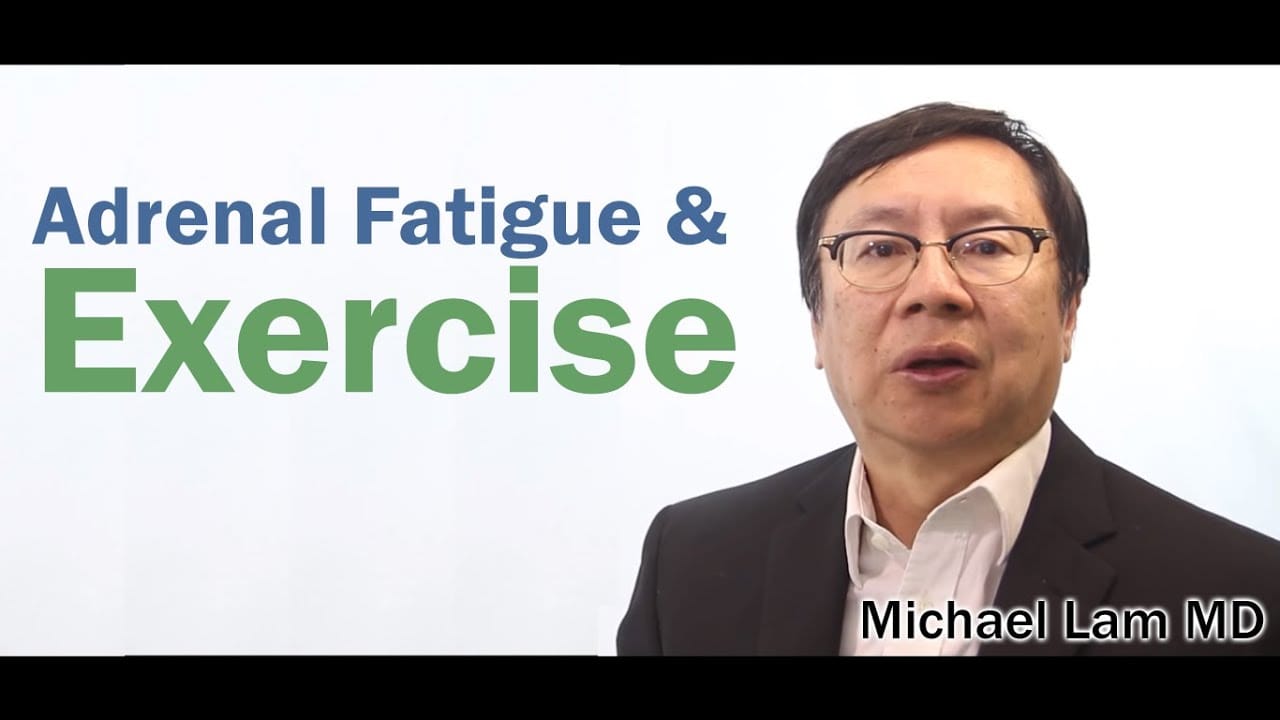
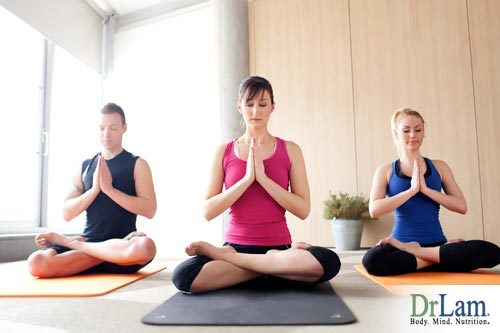 Dysfunction of the body’s ability to handle stress affects not only the adrenal glands but also the Central and Peripheral Nervous Systems. Almost all advanced Adrenal Fatigue patients have significant dysfunctional Autonomic Nervous Systems (ANS). A complete Adrenal Fatigue recovery program must, therefore, incorporate modalities designed to restore nervous system health and balance.
Dysfunction of the body’s ability to handle stress affects not only the adrenal glands but also the Central and Peripheral Nervous Systems. Almost all advanced Adrenal Fatigue patients have significant dysfunctional Autonomic Nervous Systems (ANS). A complete Adrenal Fatigue recovery program must, therefore, incorporate modalities designed to restore nervous system health and balance.
Adrenal Restorative Exercise is a set of specially designed exercises to promote deep and active relaxation. Utilizing established restorative yoga poses and adapting to enhance adrenal function, it focuses on a key aspect of Adrenal Fatigue–repairing the mind-body connection and restoring nervous system homeostasis.
Adrenal Restorative Exercise is not like regular exercise, where you focus on stretching and strengthening. For those in Adrenal Fatigue, this approach will leave you feeling physically strained and exhausted. In some, this will trigger an adrenal crash. Adrenal Restorative Exercise is different! This approach is specifically designed to help people with Adrenal Fatigue; for whom even gentle stretching is too active and for those who need to restore their health and find balance again in their lives. People who have had injuries, surgery or prolonged physical conditions such as high blood pressure will also find Adrenal Restorative Exercise a breakthrough experience. It is a special form of therapeutic exercise with a focus on healing.
Adrenal Restorative Exercise focuses on being, connecting the mind and body, allowing signals from the mind and body to reconnect in a restorative and nurturing mode. The Autonomic Nervous System responds to such modulation well. These exercises rely on a customized sequence of specially designed postures in which your body is comfortably supported. This allows your joints to be open, and muscles to utterly relax and melt into place instead of stretching and straining into position. Blood flow to the adrenals is increased, and the nervous system switches to calmness and a deep inner mode of healing.
The Essence of Adrenal Restorative Exercise:
Key sequences include:
Although the complete program of yoga for adrenal fatigue consists of twelve sequential positions or poses, here we’ll outline three of the gentlest, easiest, and most relaxing yoga poses you can try.
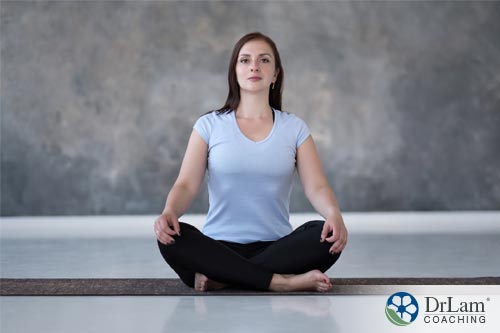 Fold a blanket so that it’s around six inches off the floor, and place a yoga mat in front of it. Sit on the edge of the blanket so your pelvis is balanced and stable. Cross your legs in the way you find most comfortable, allowing your feet to relax and the ankles to rest beneath your shins. Don’t try to bring your shins and feet inward, they should be forming a triangle with your thighs when you look down. Keep your back straight but not tight, your shoulders down, and rest your arms and hands comfortably on your legs. Breathe smoothly and naturally while sitting.
Fold a blanket so that it’s around six inches off the floor, and place a yoga mat in front of it. Sit on the edge of the blanket so your pelvis is balanced and stable. Cross your legs in the way you find most comfortable, allowing your feet to relax and the ankles to rest beneath your shins. Don’t try to bring your shins and feet inward, they should be forming a triangle with your thighs when you look down. Keep your back straight but not tight, your shoulders down, and rest your arms and hands comfortably on your legs. Breathe smoothly and naturally while sitting.
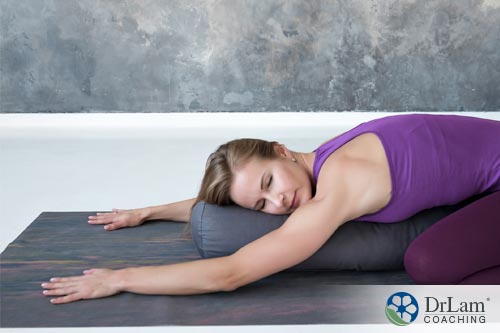 You can use a large pillow to make this pose even more gentle. Just kneel on your yoga mat, with feet together, toes touching, and knees apart in the most comfortable position for you. If using a pillow, place it between your thighs and knees so that when you bend down, you can lay your torso on it and your head to one side, placed gently on the pillow. Your arms should on either side of the pillow, bent at the elbows and resting on the mat. Without a pillow, you would bend down from the waist, with your arms straight out and your head down between them. Keep your back comfortable, and you can touch your forehead to the mat if that feels good.
You can use a large pillow to make this pose even more gentle. Just kneel on your yoga mat, with feet together, toes touching, and knees apart in the most comfortable position for you. If using a pillow, place it between your thighs and knees so that when you bend down, you can lay your torso on it and your head to one side, placed gently on the pillow. Your arms should on either side of the pillow, bent at the elbows and resting on the mat. Without a pillow, you would bend down from the waist, with your arms straight out and your head down between them. Keep your back comfortable, and you can touch your forehead to the mat if that feels good.
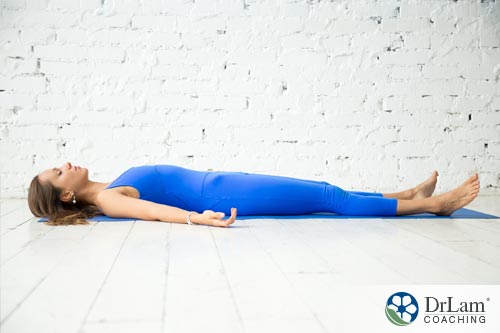 This is another gentle yet deeply healing yoga pose that is great for adrenal fatigue. Lie flat on your back on top of your mat, head and chin straight up towards the ceiling. Your legs should be about shoulder-width apart and your arms extended a little further out on either side. Allow your feet to rest in the most natural position, which means they will usually open slightly outwards at the toes. Your arms should rest on the ground so that your palms are facing up towards the ceiling. For added support, you can roll up a blanket and put it under the nape of your neck, and you can put another blanket or yoga blocks under your knees.
This is another gentle yet deeply healing yoga pose that is great for adrenal fatigue. Lie flat on your back on top of your mat, head and chin straight up towards the ceiling. Your legs should be about shoulder-width apart and your arms extended a little further out on either side. Allow your feet to rest in the most natural position, which means they will usually open slightly outwards at the toes. Your arms should rest on the ground so that your palms are facing up towards the ceiling. For added support, you can roll up a blanket and put it under the nape of your neck, and you can put another blanket or yoga blocks under your knees.
Whether you do the full sequence or just these three poses, the entire session of yoga for adrenal fatigue takes about fifteen minutes and can be as long as one hour simply by extending the amount of time spent in each position. Beginners may start with as little as twenty seconds per pose and slowly scale up.
Adrenal Restorative Exercise is particularly good for advanced Adrenal Fatigue. However, it can trigger an adrenal crash if the body is not ready. This is especially common in those with advanced adrenal weakness and in a severe catabolic state. Proceed only under professional guidance.
Yoga for adrenal fatigue has been a benefit to many. Because breathing is an automatic function, few take the time to understand its therapeutic significance in the Western Medical world. Most of us are not taught the significance of proper breathing and its healing power. As a result, the vast majority of people simply do not breathe properly while in a normal healthy state, not to mention any state of body weakness such as Adrenal Fatigue. New research shows that yoga for Adrenal Fatigue may be beneficial in achieving optimal recovery.
Three main sets of muscles are active when you breathe normally: the intercostal muscles, the abdominal muscles, and the respiratory diaphragm. All muscular activity of the body, whether it be contraction of individual cells, isotonic or isometric exercise, agonist or antagonist activity, concentric shortening, or eccentric lengthening, take place strictly under the guidance of the nervous system. breathing is special in that it involves both the Somatic Nervous System and the Autonomic Nervous System (ANS). In other words, you can voluntarily control breathing, or if you choose not to do so, the body will take over automatically. Utilizing controlled breath technique is a necessary part of yoga for adrenal fatigue. Both systems are therefore connected. The ANS is self-regulating and is not usually controlled by the Somatic Nervous System. For example, you cannot voluntarily decide to make the heart rate beat faster or slower. This is normally regulated by ANS and is beyond the Somatic Nervous System control. However, you can influence the heart rate by regulating, on a conscious level, the respiratory rate because breathing connects both nervous systems. Long exhalation will slow down heart rate during the exhalation process. By modulating our respiratory rate at will, we can influence the ANS breathing, therefore, offers an important gateway into the world of the ANS, allowing us to modulate it. This is of vital importance to those with advanced Adrenal Fatigue when the Autonomic Nervous System is invariably dysfunctional.
The ANS is broadly divided into the Sympathetic Nervous System (SNS), which is responsible for adrenaline release and the fight or flight response on one side, and the Parasympathetic Nervous System (PNS), which is responsible for rest and relaxation of the body’s internal function. In quiet times when there is less need for air, the PNS mildly constricts the smooth muscle that surrounds the airways, especially the smaller bronchioles, and thereby impedes the flow of air to and from the alveoli. But in times of emergency or increased physical activity, the SNS opens the airways and allows air to flow more easily. The PNS, by way of release of its neurotransmitter, acetylcholine, works in a dynamic balance with the SNS, by releasing its neurotransmitter, norepinephrine, to modulate and maintain homeostasis in our body. This delicate balance must be maintained for us to feel good. Yoga for adrenal fatigue helps to maintain this balance.
Adrenal Fatigue, especially in the advanced state, is invariably tied to overstimulation of the SNS. Extensive experiments have shown that Type A high-strung personalities have about threefold more plasma norepinephrine responses and fourfold larger adrenaline responses during exposure to a various laboratory and clinical stressors than compared to Type B individuals who are laid back and relaxed. These chemical transmitters of the SNS flood the body in Type A individuals, resulting in a body that is on constant alert, leading to a vicious downward spiral of compensatory responses and ultimately adrenal burnout. One key to adrenal recovery is to reduce SNS tone and enhance PNS tone. Adrenal breathing can help greatly. Adrenal breathing influences the autonomic circuits that slow the heartbeat and reduce blood pressure, producing calm feelings and a sense of stability. It calms the mind and allows the body’s internal homeostatic system to reset itself. This conduit by way of controlled respiration consciously gives us access to autonomic function that no other system of the body can boast.
 Those with severe adrenal weakness often exhibit abnormal breathing patterns. Abnormal breathing patterns in an Adrenal Fatigue setting can over-stimulate the SNS, trigger panic attacks, and contribute to adrenal crashes. We tend to breathe shallowly or even hold our breath when we feel anxious or are under stress. Sometimes we are not even aware of it. Shallow breathing limits oxygen intake and adds further stress to the body, creating a vicious cycle. Holding one’s breathe either at the end of inhalation or exhalation stimulates the sympathetic nervous system, aggravating adrenal weakness if the body is already in a state of a low adrenal reserve. Adrenal breathing Exercises can break this negative cycle by rebalancing the ANS and gently delivering more oxygen to the body for natural energy generation without over-stimulating the SNS. The body gets to take a break and reset itself to its natural state.
Those with severe adrenal weakness often exhibit abnormal breathing patterns. Abnormal breathing patterns in an Adrenal Fatigue setting can over-stimulate the SNS, trigger panic attacks, and contribute to adrenal crashes. We tend to breathe shallowly or even hold our breath when we feel anxious or are under stress. Sometimes we are not even aware of it. Shallow breathing limits oxygen intake and adds further stress to the body, creating a vicious cycle. Holding one’s breathe either at the end of inhalation or exhalation stimulates the sympathetic nervous system, aggravating adrenal weakness if the body is already in a state of a low adrenal reserve. Adrenal breathing Exercises can break this negative cycle by rebalancing the ANS and gently delivering more oxygen to the body for natural energy generation without over-stimulating the SNS. The body gets to take a break and reset itself to its natural state.
Proper adrenal breathing releases tension from the body, clears the mind, reconnects the body to the mind, reduces fatigue, and improves both physical and mental wellness. This is accomplished through enhancing the Parasympathetic Nervous System’s function. It shifts the body’s basal resting mode from a sympathetic to a parasympathetic bias.
Bear in mind that in Eastern cultures, breathing is also used as an effective modality to enhance energy and alertness by stimulating the body’s Sympathetic Nervous System (SNS). This is seen frequently in certain types of yoga breathing and is usually accomplished by various techniques involving breathe holding that gradually increases intensity and performing quick breathing exercises with high frequency (belly breathing). Another technique involves using the chest wall only to affect breathing and this is called thoracic or paradoxical breathing. The chest wall expands while the abdominal wall is drawn inward towards the back during inhalation and outward during exhalation. While these breathing techniques are empowering and increase energy flow, they can also drain the body of the already low energy state of Adrenal Fatigue. They, therefore, should be avoided in Adrenal Fatigue.
In adrenal breathing, the goal is to reduce sympathetic tone. All sympathetically driven and oriented breathing techniques should, therefore, be restricted and not be deployed until the adrenals are well healed or unless directed by your health care professional. breathing programs that do not consider this may make Adrenal Fatigue worse.
Proper adrenal breathing patterns should be smooth, quiet, regular, and rhythmic. The intensity of each breathe must match the body’s current state of a reserve. There should be no intentional breath holding or prolonging of breathing time during inhalation or exhalation. This is best accomplished by gentle breathing using the diaphragm. This is often referred to as abdominal breathing, or belly breathing because this is where movement can be seen and felt. Improper technique can worsen Adrenal Fatigue.
Beginning students and those with advanced Adrenal Fatigue (Stage 3 or higher) and weak constitutions should be very careful in the inhalation and exhalation intensity. Forcing more air in and out of the lungs beyond what the body can tolerate may drain the body of reserve and potentially have a negative effect of activating the SNS. This can trigger an adrenal crash. The intensity level may need to be titrated downwards significantly in times of adrenal crashes.
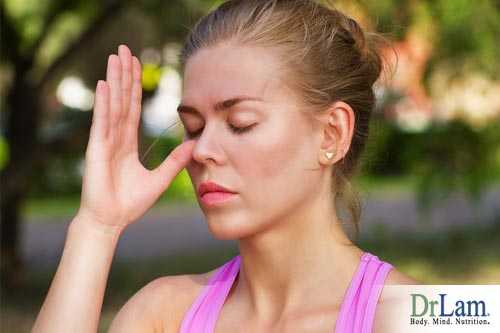 If properly done, Adrenal breathing Exercise using the diaphragm helps to restore adrenal health by enhancing parasympathetic tone, improving lymphatic circulation and clearing up toxic metabolites. The activity also improves vital capacity, supports healthy ANS balance, improves tissue oxygen saturation, and effects gentle rhythmic massage on the GI track and internal organs including the adrenals, and optimizes musculoskeletal tone. It is one of the easiest and most effective exercises anyone with Adrenal Fatigue can do at anytime and anyplace to support adrenal recovery.
If properly done, Adrenal breathing Exercise using the diaphragm helps to restore adrenal health by enhancing parasympathetic tone, improving lymphatic circulation and clearing up toxic metabolites. The activity also improves vital capacity, supports healthy ANS balance, improves tissue oxygen saturation, and effects gentle rhythmic massage on the GI track and internal organs including the adrenals, and optimizes musculoskeletal tone. It is one of the easiest and most effective exercises anyone with Adrenal Fatigue can do at anytime and anyplace to support adrenal recovery.
Adrenal breathing Exercise takes as little as a few minutes to complete and can be done anywhere at anytime. No equipment is necessary. The exact program varies from person to person. The frequency and intensity depend highly on the stage of Adrenal Fatigue. Because the wrong inhale and exhale intensity can trigger an adrenal crash, this exercise should be done under professional guidance.
Breathing exercises can be combined with meditation to bring you even more benefits. Meditation is an excellent tool in adrenal fatigue recovery because not only does it give you a structured time for you to get your breathing right, there is the added element of mindfulness.
As you focus on your breath, you can direct your mind from worry and stress to the present moment. Doing a meditation practice at different times of the day can also help with different things. For example, meditating upon awakening in the morning can help bring down adrenal hormones that had risen during the night, allowing you to start your day with more balanced levels and more resilience against stress and anxiety. Meditating before bedtime can help your nervous system, and whole body, wind down. It also brings down the levels of adrenal hormones so you can avoid sleep onset insomnia and give yourself the best chance at a good night’s rest.
© Copyright 2013-2019 Michael Lam, M.D. All Rights Reserved.
Dr.Lam's Adrenal Yoga Exercise is good to use because it progresses in intensity and endurance. It consists of 21 sessions that will challenge your fluidity, control, core, and balance.
Lightweight strength training would be better. Light walking, biking or swimming is good cardio to do also. It really depends on the severity of your symptoms after you exercise. Start your recovery with rebuilding core strength is the key, and the Adrenal Yoga set of exercises is designed to do this systematically and gently.
Yoga exercise can be very mild or very intense. With proper guidance, the exercises can be personalized to your need. Dr.Lam's Adrenal Yoga Exercise is a good example of how to increase the intensity as you improve your AFS.
Depending on the stages of your AFS, exercises should be done with caution. Swimming is a very good exercise. Swimming in salt water or natural body of water is better than a chlorinated pool.
Anytime you need to build muscle, you need to strain those muscles. As a result, you can affect the heart rate. There should be no issues if your adrenals are strong and able to handle the stress of heavy exercise.
